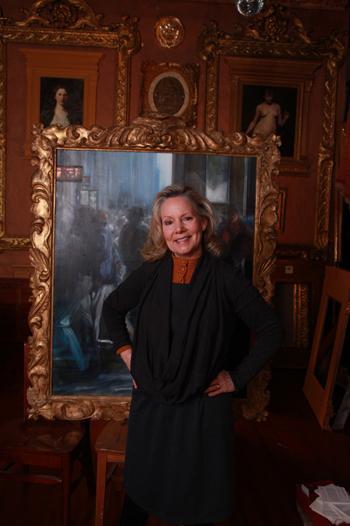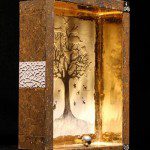Kay Jackson at Addison/Ripley
By • February 8, 2012 0 3226

Kay Jackson is a local artist whose paintings have garnered national and international acclaim, including a commission by President Clinton for the official White House holiday card in 1997. Working in an inspired sunroom-studio on the third floor of her Dupont Circle home, she has long focused her work on addressing environmental concerns, such as endangered species, pollution and the loss of animal habitat. Her current exhibition at Addison/Ripley Fine art, running through March 3, continues her decades-long pursuit and calls upon the near extinct artistic tradition of gilding to help communicate her vision.
Jackson has long employed gold leaf techniques in her work and for the exhibition has created gilded icons of endangered species, drawing parallels to the endangered crafts she employs in the work’s creation.
Jackson learned the art of gilding through her husband, William B. Adair, a master gilder, frame historian and owner and founder of Gold Leaf Studios in Dupont Circle. Adair is among a small handful of international authorities on frame fabrication, conservation and the nearly extinct art of gilding: applying fine gold leaf to the surfaces of paintings, wood, frames or anything else you could possibly conceive. He has employed his expertise extensively with every major museum in the city and consults with gallerists, architectural firms and private collectors throughout the world.
The oldest and most common form is a process called water gilding, Jackson explains. After first applying layers of gesso to linen or wood — for a painting or a frame — the gilder then applies a layer of clay and glue, called bole, to help the small thin sheets of gold leaf adhere. The applied gold is then burnished and can be lightly manipulated. For a textured, dynamic surface, such as embossed vines wrapped about a picture frame, warm gesso can be carefully ladled upon the surface to create the patterns before laying the gold leaf, a process called pastiglia.
Examples of gold leaf abound in museums and buildings around the District, perhaps most prominent displayed in the National Gallery of Art’s permanent collection of 13th and 14th century Italian paintings, which is all but overrun by brilliant gold leaf altarpieces.
But rarely is gold leaf seen employed in contemporary settings, and in these gilded icons of endangered species now on display, Jackson has drawn a remarkable and fitting parallel to the ancient, endangered craft of gilding.
A technically brilliant artist in every sense, Jackson has made more than just paintings in these gold leaf works. They are intricate, cryptic, glowing panels and boxes that Jackson has constructed entirely, encasing the endangered animals — from crayfish and salmon to the spotted owl — in armatures of gold and surrounded by symbols that span multiple time periods and iconologies.
Jackson custom designs the frames for each work, inspired by 14th century panel paintings. She herself observes that her boxes are like 16th century cabinets of curiosities, those assembled by wealthy European collectors to celebrate and catalogue their knowledge of the world. Yet despite these callings upon the past, the works look completely contemporary. Her pieces depict both the fragility and resiliency of our ecosystems and species, and they connect the vulnerability of our planet with the delicacy of our artistic culture. This is also echoed in the act of creating the work itself. “Creating art is an act of faith,” Jackson says. “With each passing year it takes an increasing commitment to continue what most people think is a spontaneous and blissful activity.”
More of Jackson’s series of gilded endangered icons will be on display at the Muscarelle Museum of Art, the museum for the College of William & Mary, in Williamsburg, Va., accompanying a historic frame exhibition by husband Adair on the history of frames from the Byzantine to modern period.
For information on Kay Jackson’s Addison/Ripley exhibit, visit AddisonRipleyFineArt.com. For information on her Muscarell Museum of Art exhibit, visit Web.wm.edu/Muscarelle.
- Kay Jackson with her paintings | Photo by Phillip Bermingham



